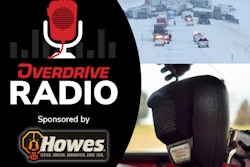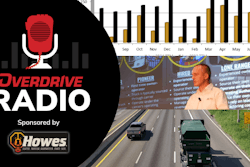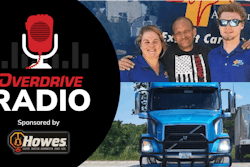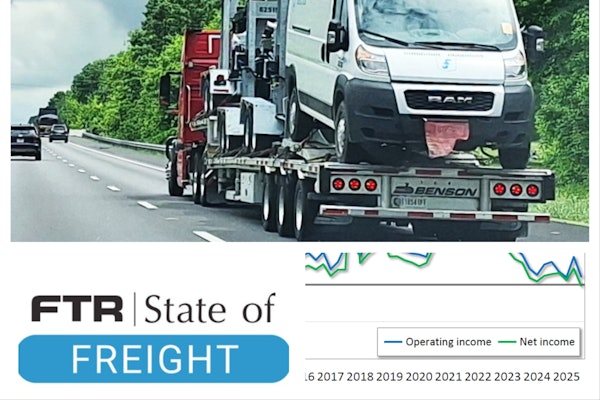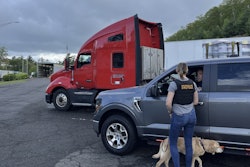Former CVSA president Steve Vaughn, currently vice president of field operations for PrePass, stressed asking the tough questions about technology and all the infrastructure put in place to support it when it comes to roadside inspections and over-the-air communication from the truck to law enforcement. Getting answers to those questions, some of which he details in today's edition of Overdrive Radio, is absolutely key to ensuring any potential rulemaking around electronic ID is something industry and enforcement can agree on. And hopefully without the unintended consequences that often arise in the rush toward federal implementation of new programs.
[Related: Electronic IDs for trucks: 'Big brother' or a step forward?]
PrePass' Vaughn was speaking long before the FMCSA's current request for comment on the topic, but drew connecting lines between electronic ID (sometimes referred to as UID) and the agency's long pursuit of so-called "Wireless Roadside Inspections," or WRI, a program to automate both vehicle and driver inspections with communications technology. WRI now become a more limited version of what the old program originally envisioned, in the form of CVSA's Level 8 electronic inspection standard.

Study and technology development around WRI go back to at least 2006, when the agency was provided funding for a four-year study that morphed into at least nine years of funded research. "Congress in 2018 told them you’re no longer to spend money on it," Vaughn said, speaking in March at the Truckload 2022 conference in Las Vegas. "You’ve been looking at it for 10 years, that’s enough."
Around that same time, though, he added, "we saw it move over to CVSA in the form of a Level 8 inspection." Though the new standard for electronic inspections has been official in CVSA's inspection program since June 2017, "not a single Level 8 inspection [has been] conducted to date," Vaughn said in March.
FMCSA's September ANPRM around electronic IDs did note that the agency has been testing Level 8 inspections as a means essentially to do what CVSA Executive Director Collin Mooney described in Alex Lockie's story yesterday -- assess basic safety at highway speeds and thus target only trucks, operators and carriers that need it.
CVSA's Level 8 electronic inspection standard itself, as Vaughn noted in March, requires the capture of where the truck is via "GPS coordinates, information about the driver. ... Are they licensed to drive the class of vehicle they’re in, do they have their medical? Hours of service information -- are they current, is it up to date? Skill Performance Evaluation Certificate -- does it meet the requirements? On the vehicle -- DOT number, registration. UCR: is it current? What is the operating authority, and does [the carrier] currently have federal out of service violations?"
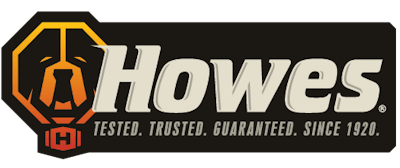 Overdrive Radio is made possible with the support of Howes. Find out about their diesel additives, lubricants and more via HowesProducts.com
Overdrive Radio is made possible with the support of Howes. Find out about their diesel additives, lubricants and more via HowesProducts.com
[Related: CVSA launches autonomous inspection program/standard]
Citing his past with the California Highway Patrol and with CVSA, Vaughn said that during his 40 years of experience around trucking and government, he's seen the tendency particularly for governments to want to "get a program forward so quickly that they don’t properly vet it all the way through."
Though Mooney with CVSA said he envisioned electronic ID in particular as a means of sharing nothing more than the ID itself with law enforcement in any given local area, if it makes the Level 8 inspection possible, Vaughn asked what happens to violation, location and other data generated as a result? Who owns the data? Will it be public? With vehicle-miles-traveled use-tax systems being tested and deployed in some areas as an alternative to apportioned fuel taxes, can truckers "expect a bill from each state" based on roadway use data collected via UID?
"I think that’s a real possibility," he added about the last of the questions above. You can hear much more from his talk through the connecting threads in today's podcast, take a listen:
Also in the podcast: After a technical snafu last week, Overdrive Radio's new podcast message line is operational -- listen to find out how to dial in with your story to receive a prize pack from our sponsors at Howes, including its Diesel Treat and Diesel Lifeline anti-fuel-gelling treatments just in time for the Winter season.
Links mentioned in the audio of the podcast, for reference:
**Where to comment on FMCSA's electronic-ID ANPRM
**Alex Lockie's "Electronic IDs for trucks: 'Big brother' or a step forward?
**A tutorial around challenging preventable crashes in FMCSA's fairly new program conducted through the DataQs system
Podcast transcript:
Steve Vaughn: Government tends to have a tendency to want to get a program forward so quickly that they don't properly vet it all the way through.
Todd Dills: That was the voice of former CVSA President Steve Vaughn. He's currently Vice President of Field Operations for the PrePass Alliance, providers of the well-known weigh station bypassing system. He was stressing there why he feels it's important for any government program to get the tough questions answered before rushing forward. He ended up citing the CSA inspection data mining and safety scoring program as a marquee example of a rushed implementation with plenty perhaps unintended consequences. Anyone who's been around trucking during the last decade will know well the problematic nature of the scoring system for small carriers in particular, not to mention crash accountability issues, at least partially remedied in recent years. Steve Vaughn discussed all of it this past March in Las Vegas at the conference of the Truckload Carriers Association, yet I thought it made perfect sense to revisit his talk given the current comment period open around FMCSA's exploration of requiring trucks to be able to communicate a standard electronic identifier wirelessly to the roadside.
I'm Todd Dills, your host for this edition of Overdrive Radio. Vaughn effectively connects the dots between the discussion around the transmission of electronic IDs, often referred to with the UID acronym for unique ID or universal ID. Vaughn connects the dots between UID, FMCSA's long pursuit of a “wireless roadside inspection” program, CVSA's Level 8 electronics inspection standard, and the recent years' emergence of advanced drive assist systems and various companies' pursuit of fully autonomous trucks. Those trucks have to be inspected by law enforcement somehow, right?
Vaughn noted an established electronic ID system he viewed as a stepping stone to get to those Level 8 inspections, and those as charting a path toward what CVSA announced earlier this week. Just as I was starting to put this week's podcast together. At its most recent meeting, CVSA adopted a new standard for inspections of automated vehicles. Turns out these vehicles may not exactly be inspected by law enforcement as much as they are by the controlling motor carrier and its personnel certified to CVSA standards for that purpose. There's more to it than that though. And Vaughn, in response to a question from the audience back last March, gave a fairly realistic assessment of the vision for what a connected fully autonomous truck might be able to communicate with the roadside.
Steve Vaughn: Now with the AVs, the autonomous vehicles, what they're building into the system is those trucks will have on all the critical components on that vehicle, brakes, brake lights, steering, other items, they will all have sensors on them. They'll be tested before they leave the yard. As it's driving down the road, if any of those sensors indicate there's a problem, then that vehicle will be required to pull in. But as a former enforcement person, I know that there's other things that sensors can't determine. One is load. There are no sensors going to tell if that load secure. Two, a cracked frame, cracked sprain, other things. Sensors aren't going to detect that. Only an inspector underneath the truck will.
Todd Dills: Motor carriers using such trucks under CVSA’s new standard are envisioned to be required to conduct point-of-origin and destination inspections, including inspections at specific intervals throughout the trip. You can read more about it via this link. And Vaughn elaborates much more in the talk that follows on the stepping stones that have led to where we are today with a public discussion around the basic electronic identifier idea. Read Overdrive's Alex Locke's story published just yesterday for what CVSA's Collin Mooney envisions from the ID transmission. Mooney said he's hopeful it will apply only to new truck builds, but the fact is that FMCSA is asking about the safety regulations, not just the new vehicle standards controlled by the National Highway Traffic Safety Administration. As Vaughn will illustrate, if this ever gets to the point of an actual regulatory proposal from FMCSA, it could go anywhere in its potential applicability to trucks whose controlling computers are potentially capable of accommodating retrofit.
Though CVSA’s Executive Director Collin Mooney said he doesn't support aftermarket products used to communicate vehicles' electronic ID with roadside, ELDs or in-cab telematics equipment is already being used for similar purposes and partial automation of inspection procedures today, as noted in the story yesterday. Systems like Vaughn's, companies for weigh station bypass, likewise, already communicate fairly significant amounts of information to the roadside wirelessly. Not to mention the presence of license plate and DOT number readers all around. On the other side of a quick break, Vaughn lays out the evolution of the pursuit of an electronic ID standard up to today and really asks some of the tough questions he feels it's necessary to answer before any rush to implementation.
Before we get there though, I wanted to say apologies to all of our listeners to last week's podcast. The dial-in number I gave for a chance to win a prize pack from Overdrive radio sponsor, Howes, was working when I put the podcast together, but technology, right? Somewhere along the way, my attempts to get it back up and running after having not used it for a while, they succeeded and then failed, and I wanted to make note of the new number, 615-852-8530, for the Overdrive Radio podcast message line. Like I said last week, I've got price packs including Howe's diesel treat and diesel lifeline anti-gel fuel treatments for a limited number of callers. Call in, tell us your winter fuel gelling story, and/or your experience using Howe's fuel treatments or other products. You can do that with a call to our podcast voicemail line that new number, 615-852-8530. That's 615-852-8530.
Speaker 3: With winter fast approaching, it's time to prepare yourself for the conditions that lie ahead by adding Howe's diesel treat at every fill-up, you can prevent your diesel fuel from gelling in even the coldest temperatures. While it safely removes water, adds lubricity, and prevents deposits, the nation's number one anti-gel will help protect your engine and provide you with the added power you crave. Backed by the only no tow guarantee. Howe's diesel treat will keep you rolling no matter what weather comes your way. Learn more at howesproducts.com. Howe's. Tested. Trusted. Guaranteed.
Todd Dills: That's Howe's, H O W E S. Howesproducts.com. Here's Steve Vaughn of PrePass.
Steve Vaughn: Thank you. As indicated, I'm the Vice President of Field Operations for the PrePass Safety Alliance. I also wanted to let you know my background. I'm not only on industry background, but I was with the California Highway Patrol for nearly 30 years, retired as the chief of the enforcement services division, which had oversight responsibility for commercial motor vehicles. So this presentation's coming from the perspective of both industry and enforcement. And now that I've confessed I'm former law enforcement, I'll stay on my feet. I'll continue to move around the stage because I know a moving target's much more difficult to hit than a stationary.
What I'm going to talk about today is WRI and UID and a couple other things. How many of you are familiar with WRI or universal ID? Anybody? Wireless roadside inspection. That's something that's been talked about for a number of years now. I'll tell you a little bit more about it. Where it is today and where it's going in the future. Universal ID, again, has been talked about for many years, hasn't had a lot of success in moving it forward. We'll talk about some of the recent developments, what is happening today, and what may be happening in the future. And why should you care? I'll talk about what's going to happen with the trucking industry and my viewpoint based on some of these things that will be occurring. Universal ID is something that's been talked about by many organizations since the early 2000s, primarily because what it does is it assists a state in identifying a vehicle as it's traveling down the road when that vehicle, of course, is a truck. CVSA has been an advocate for UID.
They would like to see this take place and quite frankly so would I. I think it has its place in the trucking industry and in the enforcement industry. They filed a petition back in 2009 with FMCSA, which was later denied in 2013. FMCSA then took it up again and denied it a second time in 2015. CVSA then filed with NHTSA, hoping NHTSA would jump on board with this, but they denied it. Last fall, there was legislation in the US Congress to actually make UID law, and that failed. And I think it failed for a number of reasons that we're going to talk about here shortly.
Wireless roadside inspection. This is a means in which information's going to be transferred from the vehicle to a weigh station or inspection facility electronically as a vehicle is coming down the road. FMCSA was provided funding for this back in 2006. It was to be a four-year study. What happened was they completed some of the material they needed to do. They can then continued on research and development funds provided FMCSA and that did not end until 2015. Again, the concept is information's passed forward so the officers will have that sitting in front of them before the truck even arrives. As a result of wireless roadside inspection, really not going anywhere, in fact, Congress somewhere around 2018 told FMCSA, "You're no longer to spend any funds on wireless roadside inspection. You've been looking at it for nearly 10 years. It's gone nowhere. That's the end of it."
We saw it move over to CVSA in the form of what they call the Level 8 inspection. They spoke, and I am a past president of CVSA so I know how the system works there. It's rather slow. But they had some subcommittees get together and talk about what kind of information should be pushed forward to the enforcement people at the facilities. What they decided on, and I was part of those discussions early on, they were looking for everything from is the driver wearing his seatbelt? Can that be determined and sent forward? To brake checks and everything else. They realized that was too much.
So what they did is they narrowed the scope and this is the current Level 8 inspection. It talks about the location the truck is at, GPS coordinates, information about the driver, such as driver's class. Are they licensed to drive the class of vehicle they're in? Do they have their medical? Hours of service information? Are they current? Is it up to date? Skill performance? Evaluation certificate? Does it meet the requirements? And then on the vehicle, what they're looking for is the DOT number registration on the vehicle. UCR, is it current? What's the operating authority it's classified as? And does it currently have any federal audit service violations? This was passed by CVSA in 2017. They haven't had a single Level 8 inspection conducted to date. And in just a minute we're going to talk about.
Todd Dills: Quick reminder that Steve Vaughn was speaking in March this year at the Truckload 2022 Conference. In FMCSA's recent request for comment on the notion of requiring trucks to be able to communicate a unique ID to the roadside, the agency did make note of the fact that the Level 8 inspections are in fact being tested by agency personnel, the state partners. They characterize such inspections much like Collin Mooney characterized the likely roadside reality should electronic ID or UID become a reality. That is, a way to assess safety at highway speeds and thus target only trucks, operators, and carriers that truly need it. Presumably, though, carriers will get some credit for a full Level 8 inspections should it become an operational reality at the roadside. Electronic ID requirement won't get us all the way there necessarily. Again, PrePass is Steve Vaughn in March speaking to developments around the very notion of the Level 8 inspection as they said at the time.
Steve Vaughn: While this was going on and it's starting to stall, it really hasn't gone anywhere. Autonomous vehicles came along. So you have a number of organizations, CVSA, ATA, FMCSA, NHTSA, both government and private, working together to set some standards and determine what will happen with AVs. An autonomous vehicle is essentially a vehicle that is traveling down the road without a driver remaining in contact with other vehicles through the 5G technology. Through this 5G technology, it's also expected that these vehicles will be able to communicate with traffic signals, the road itself in some cases, other signs that are out there. It's a very interesting concept. It is actually being tested today in many states. I shouldn't say many. A few states. Probably the number one state is Texas right now. I was at a conference two weeks ago where we talked about this.
Over 1900 trips have been made in an autonomous vehicle in that study. However, there is a requirement. There's a driver on board to take over should the computer fail in any way. So it's not truly autonomous at this point, but many of those trips were made without the driver interaction. How many we're not exactly sure because one of the questions that was asked was, "How many do those trips did the driver have to interact with the vehicle when the computer failed?" And we weren't provided an answer. Whether the individual didn't know or simply didn't want to say, I don't know. But I think that's an interesting question that needs to be asked somewhere in the future.
Todd Dills: Since the time of Vaughn's talk, we’ve continued to see PR around autonomous runs, including one company touting a development allowing law enforcement to pull over a truck operating with its system for a roadside inspection, and another company trying mightily to explain what caused one of its vehicles to abruptly swerve and crash into a jersey barrier to the huge surprise of its in-cab operator. Federal officials investigated that instant. That's all among the reality that many of these trucks in various states are out there among you making runs, hauling freight, learning such as a computer can while under the tutelage of an in-cab operator as Vaughn noted for now.
Steve Vaughn: So you can see how it's progressed in the convergences of this. We have WRI, you have the identifier of the vehicle, you have the first step, which is the Level 8. All three of those are going to be components that are going to be required in autonomous vehicles. Here we get to what's the impact on trucking, and there are a lot of questions out there. Now you may get the impression that I'm opposed to this type of concept, I'm not. I think it'll improve safety on the roadway. That one of the things in 40 years of law enforcement experience, because I still work with the states, I still work with the feds, is government tends to have a tendency to want to get a program forward so quickly that they don't properly vet it all the way through. How many of you are familiar with CSA?
Remember when it first came out it was CSA 2010. That was because Congress says you have to enact it by 2010. So what did we do? We rushed through that. We got it almost in place, but here we are... What is it? 12 years later and some of the things we were going to fix back then have not been fixed. For example, how many of you're familiar with the crash indicator in your CSA score? You could be stopped at a red light, a passenger vehicle runs into the back of you. That's charged as a crash to that carrier. That impacts your ISS score, your CSA score. Now, it took FMCSA almost seven years to partially fix that. How many of you are familiar how you can correct if you're charged with a crash? Okay, a few of you know. Through DataQs, you can go in and challenge that crash, have it removed. And if you have several of those, you can see an improvement on your ISS score.
Todd Dills:
Improvement for an ISS score -- that stands for Inspection Selection System, ISS -- Vaughn noted here is that improvement is when it goes lower. Removing non-preventable crashes in a variety of categories is now a reality through the DataQs system. If you have never attempted to do it, we did publish something of a tutorial on the system in 2020 when after a trial run it went live in full. Though the look and feel of some of the functionality of FMCSA's DataQs' site has changed since then, most of the basics of the program in that tutorial still apply. Find a link to it here. The CSA program generally Vaughn called an example.
Steve Vaughn: Of why I don't believe we should always leap forward without making sure we've asked a lot of questions. We've vetted the answers, made sure that we have everything in place, particularly when we get to the point of AVs, autonomous vehicles. Because you're talking about a failure. There's no one in the truck to take it over. So these are some of the areas I think questions that need to be asked. I frequently ask them, there are others out there that ask these questions, and I think we need answers. Requirements for the UID and Level 8, is that going to be a regulatory requirement where all of you will be required to have a system that will able your vehicle to send a message forward?
Todd Dills: Which of course FMCSA is asking directly about now. In fact, many of the questions Vaughn raised are raised by FMCSA's request for comment around electronic ID, or UID as he refers to it itself.
Steve Vaughn: If so, who's going to pay for it? I think you all know the answer to that one. You are. With the states, as a former state guy, who's going to pay for the states to implement the required, the technology required to accept that information and then display it? The state will. Common practice we see with FMCSA is they give grant funding upfront, which is great. We can start the program, but then the state is then responsible to maintain it and replace the equipment as it ages out. So it becomes an additional burden and expense to this state just as it will, I believe for the trucking industry as technology advances. Oh, the other thing is will they make it? Quite often what we'll see is a regulation that says any vehicle manufactured after this date is required to have this as part of the vehicle. Occasionally they'll attach something that says by 2030 all vehicles must be retrofitted to meet this requirement.
We don't know what they're going to do with that. UID, what will be the identifier on the vehicle? Now I'm a strong advocate for make it the VIN Vehicle Identification Number. That's a requirement on every vehicle that is put on the road. All of your trucks, your trailers have a VIN number already attached to it. In the discussions we've heard, they were talking about, you send all kinds of information forward, your route, vehicle registration, license plate, everything in the world is what they were looking for to come forward. I think if we can narrow it to one identifier such as the VIN, that makes sense. It's logical, it's available on the truck. Your onboard computer will know that number, and if we get to a point where it has to be sent forward, it's already part of the system. VMT, who's familiar with VMT? Vehicle Miles Traveled.
So as we've seen gas tax revenue coming in decreased Congress over the last few years has been looking for an alternative way to collect funding to keep the roadway surface systems going. One of the things they talked about is VMT, Vehicle Miles Traveled. If we have a system in place, and this is, I'm simply asking the question, if you have a system in place that's tracking the truck in each inspection facility, as you go through a state, you think you can expect a bill from the state indicating this is what your tax is based on what we've collected on you? I think that's a real possibility. So I know of two states that have already built their own system. One we have had a lot of discussion with. They're looking at even putting readers on off-ramps and on-ramps. So they're going way out there. It may or may not be, but VMT as a precursor in the back of their mind saying, "Let's look at this."
Speaker 5: Boo.
Steve Vaughn: Who?
Todd Dills: Yes, that was a member of the audience booing this particular idea.
Steve Vaughn: Oh, boo. Yeah, boo. That one I agree with. Next up is who owns the data? Do you own it as the carrier? Does the state own it once you pass it forward to them? If the state owns it, is it going to be available to the public? Generally not. But under a FOIA, Freedom of Information Act, you're required by law to send that information forward so it will be made public.
Todd Dills: CVSA executive director Collin Mooney, speaking to Overdrive this week, sought to tamp down some of the concern around the notion of an electronic identifier, but noting that UID in his view should be just that. What Vaughn noted too earlier, simple communication of a VIN or other ID to law enforcement roadside. At which point then existing systems can be queried to assess the safety record or recent inspection history to target enforcement correctly. Yet, if we get to the point of Level 8 inspections, I'd say Vaughn is right and that such data will likely feed right into the CSA system. And for instance of the inspection and any violations, yes, it will in fact find its way into the public.
Steve Vaughn: Security and use of the data. They still haven't defined how it's going to be sent forward. There are security protocols whenever something is sent forward electronically that are fairly good, but I just saw a sign back over here as we're being attacked all the time. How many times do you get warnings that this is a public access, and your information may be intercepted? And again, I'm not saying it's not possible, I'm just saying let's define that before we move forward with something. Violations. These bottom two are important to me, especially having been in California and recognized how often states get sued. All of you have heard the nuclear lawsuits out there that are occurring to the trucking companies. You guys are the big guys when there's a crash. The states are the big guys when there's a crash. So with violations, what will the impact be?
If you're driving down the road and they identify you need to pull in. Anybody know what the out-of-service rate is for trucks these days? 21%. That means 21 out of every 100 trucks that are inspected, and that's the key, that are inspected or placed out of service for a violation. Drivers, currently, it's around 6%. The challenge is in reality enforcement only, and this is an old estimate and I think it's still true personally, enforcement only inspects two to 3% of all the trucks on the road.
If we start doing it electronically, what are we going to do with all the trucks that are being pulled in? Where's enforcement going to put on? How's that going to interrupt the supply chain? I think it's going to be significant. I'm not saying don't do it if there's an unsafe vehicle running down the road, we need to get it off the road. But we need to figure out what are we going to do with it? Who's responsible? The driver, the carrier, or the state? And that's going to be a big problem if a crash should occur once that vehicle's been identified with an issue or the driver's been identified as having an issue and if they continue down the road. So again, this isn't to kill anything. It's simply to make you think, to have the government think. There are still a lot of unanswered questions out there that can be solved but before we move forward with the program, let's get those answers in place.
Todd Dills: As noted, FMCSA's request for comment on some of the questions raised by Vaughn here is open with the central question being whether the safety regs should require electronic ID transmission capability for commercial trucks. As Vaughn and CVSA's Collin Mooney both suggested that can take different forms, whether it's what Mooney says he favors, a requirement, new builds only, to use of add-on systems like the electronic logging devices in use in so many of the nation's freight carrying trucks to something else entirely. You can find a link to the essential request for comment document for all of FMCSA's questions, more background via the show notes, or the post that houses this podcast for October 7th, 2022.
Thanks for hanging with us through the end. And again, big thanks to Howes for their support. As I noted earlier, for a chance to win a prize pack, including bottles of Howe's diesel treat and diesel lifeline anti-gel fuel treatments and more, tell us your winter fuel gelling story or your experience using Howe's products. You can do that with a call to our podcast voicemail line at 615-852-8530. Again, apologies for this past week's snafu on our older number. Tell us your name and location with any message, and we'll be back in touch for shipping information.




